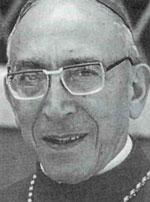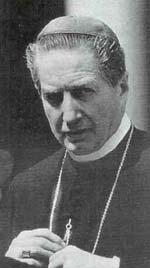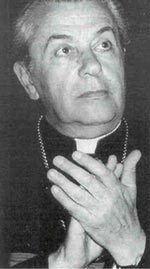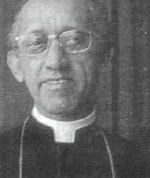

![]()
![]()
|
November 1996 No. 18
Also in this book is a report on the role of the former Secretary of State, Card. Casaroli, in the preparation of the next Conclave. It is not coincidental that a long program devoted to the Cardinal aired on Italian television recently (Jan., 1996) or that he gave several interviews to various journals at that time. Looking ahead to the role which he could still play at the time of the Conclave, the Cardinal has judged it necessary to appear in a new light, washed of the stains of the Ostpolitik. He has done this by making Paul VI bear almost all the responsibility for it, especially that concerning the well-known case of the great Card. Mindszenty. Some might think that the leaders of the power group so often discussed in Si Si No No are too old and no longer have a chance of success in the next Conclave, but it isn’t so. Earlier, it seemed that they would orient their choice towards a South American with pastoral and curial experience in order to have a candidate capable of rallying a large consensus, but this candidate [Msgr. Lucas Moriera Neves - Ed.] is “out of the race” given his health problems.
That leaves Card. Martini. Zizola devotes an entire chapter to him. Martini continues to publish books which invariably carry his photograph on the cover; he travels all over the world, giving conferences or preaching the “spiritual exercises.” His agenda is a full two years ahead. He is going out of his way to make himself known to a large part of the electors of the Sacred College. It isn’t known if Zizola’s book was overseen by the liberal-radical wing of Card. Silvestrini, but it is certain that Zizola is an unconditional supporter of that wing. Si Si No No once reported:
THE SECOND EVENTThe second event is the important article by Vincenzo Card. Fagiolo, published in the 30 Day (Feb., 1995; Italian edition) entitled "Resignation of the Papacy and of the Episcopal Office." Card. Fagiolo, a noted canonist, concludes that "lack of health and strength" is a reason for resigning, a reason which finds "explanations within canonical tradition and the regular practice of the Church." One must recall Card. Fagiolo's role at the time of the concordat between Rome and Italy which ultimately meant the de-Christianization of Italy. Card. Fagiolo not only contributed to the editing of the concordat, but he also was its great defender in the press (Il Tempo, Feb. 11, 1984; Feb. 19, 1984). In defending the concordat, he also defended those who were responsible for it: Casaroli and Silvestrini. Why this article in 30 Days? Is this another of his strategies of defense? Does Fagiolo wish to present arguments in favor of the group which wants to prepare the next Conclave? To know a person, one must also know his friends. Let it be known that Card. Fagiolo is a close companion of Silvestrini and Virgilio Card. Noe, and without any doubt, he is the great defender of the work of Msgr. Bugnini, the principal demolisher of liturgical tradition. THE THIRD EVENT
The third happening is the Apostolic Constitution Universi Dominici Gregis (Feb., 22,1996). It seems to contain nothing new which could concern the proceedings of the Conclave. That was the opinion of the journalists who did nothing more than report what His Excellency Msgr. Jorge Maria Mejia had told them during the press conference at which the document was presented. Moreover, as Secretary of the Sacred College, and thus of the next Conclave, Mejia was certainly the best informed person on all that could concern the election of the next pope. He said: Thus, those who wish to seek out, or expect to find, substantial changes in the current compilation of the norms would be disappointed…. What are the changes...? They are, fundamentally, three small ones...(Osservatore Romano, Feb 24, 1996). He specified them thusly: I) The Conclave fathers would reside in the newly prepared Domus Sanctae Marthae residence, not in the Apostolic Palace as in the past; 2) two traditional methods of election, by acclamation and by compromise, are now abolished; 3) special security measures have been mandated to insure the isolation and secrecy of the conclave proceedings. However, that is not all that the text of the Pope's constitution says, and Mejia contradicts (by omission) what the Pope himself wrote:
This really is an important change, the only substantial innovation in the constitution. Why did Mejia pass over it? Here is the important change: If, after 30 votes (which, at four votes per day would mean on the eighth day) no one obtains two thirds of the votes...
This is not a small change! This is changing a practice of more than eight centuries. The traditional two-thirds majority rule was fixed by the constitution Licet de Vitanda (1179) for several reasons: to have a candidate approved of by a large consensus, and, above all, to avoid any doubt about the election of the successor of Peter. If in fact the election is made by majority vote (as it will be now after 30 ballots), the new Pope could be elected with half of the votes plus one; and if there is one invalid, or dubious, or uncertain vote, his election will be null, or in doubt, or uncertain. One thus runs the risk of having two Popes and the risk of disputes which could even end up in schism. The change brought about by the recent apostolic constitution is then a very important one, one which could have incalculable consequences for the future of the Church. In regards to this, Andrea Tornielli writes:
AT THIS POINT, SI SI NO NO QUOTES THE FOLLOWING LETTER TO THE EDITOR FROM AN ARGENTINEAN PRIEST:
Here are a few more bits of information on His Excellency Msgr. Mejia. He is a licentiate in Biblical Studies at the Pontifical Biblical Institute, that crucible of the present crisis, well known for its contempt of the constant magisterium of the Church. In Rome it is said that the nomination of Mejia as Secretary of the Congregation for Bishops was due to his old friendship with John Paul II, dating back to the time of the Pope's studies at the Angelicum. It seems that the "friendship" was dusted off and polished up in order to place Mejia in a position that he coveted. Mejia does in fact have some old friends in Rome, like Pia Card. Laghi and his friends in the group of Brisighella (Faenza), including Achille Card. Silvestrini, today Prefect of the Congregation for the Eastern Churches. Mejia knew Laghi when the latter was in Argentina, and Laghi prepared the way for Mejia's first appointment in Rome. Thus Mejia feels indebted to Laghi and he takes any occasion to thank him, as for example in the review he wrote for the book, Card. Pio Laghi: Honorary Citizen of Bethlehem, on the occasion of the Cardinal's 70th birthday. The wildly emotional eulogy that he made of this book is such that it casts doubt on the sincerity of the author's assertions. Laghi, Silvestrini, and their companions certainly have the advantage of having a friend at the Congregation for Bishops. The Secretary of this Congregation plays a key role in the nomination of bishops. It is he who chooses the cardinal relator for every episcopal nomination. Who can prevent Mejia from naming Silvestrini, Laghi, Fagiolo, Poggi, Fumo, etc. as relators for the key posts? In the article "Human Maneuvers in Preparation for the Next Conclave," we wrote:
Today it is even easier: one third of the cardinals, by voting as a bloc, can unleash the mechanism of the majority-vote rule. This will happen even more easily since the new residence of the electors in the Domus Sanctae Marthae no longer presents the inconveniences found at the Apostolic Palace which aggravated among the cardinals a certain haste to reach a conclusion. We have illustrated three points of the strategy for the next Conclave. There is probably a fourth. There are rumors that there may soon be a consistory to create a small number of new cardinals. There are only a few posts vacant, but they are sufficient to reinforce an existing power group. Among the candidates for cardinal are: Msgr. Mejia, who aspires to succeed Card. Gantin, whose term expired a year ago. It would be an unusual event in the Curia for the Secretary to succeed the Prefect, but today anything is possible; Msgr. Marchisano, who characteristically does everything possible to obtain the cardinal's hat, benefiting from the same Piedmontese origin as the Secretary of State; Msgr. Dino Monduzzi who, even though suffering from Burger's disease, won't quit his post until he makes cardinal. All these rumours are disquieting. Beyond the three events that we have related in this article (Zizola's book, Fagiolo's article in 30 Days, and the Apostolic Constitution Universi Dominici Gregis), is there perhaps more in the works?
Courtesy of the Angelus
Press, Kansas City, MO 64109 |




